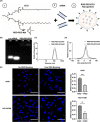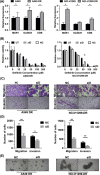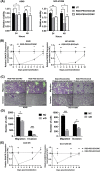Regulating Oncogenic LncRNA DANCR with Targeted ECO/siRNA Nanoparticles for Non-Small Cell Lung Cancer Therapy
- PMID: 35811871
- PMCID: PMC9260776
- DOI: 10.1021/acsomega.2c02260
Regulating Oncogenic LncRNA DANCR with Targeted ECO/siRNA Nanoparticles for Non-Small Cell Lung Cancer Therapy
Abstract
Long noncoding RNA (lncRNA) differentiation antagonizing noncoding RNA (DANCR) is a proven oncogenic lncRNA across multiple cancer types. Its effects on cancer cell migration and invasion position it as a potential target for therapy on multiple levels of gene regulation. DANCR is overexpressed in non-small cell lung cancer (NSCLC), the most common lung cancer subtype with poor patient survival. To effectively deliver small interfering RNA (siRNA) against DANCR for NSCLC therapy, we used arginine-glycine-aspartic acid (RGD)-poly(ethylene glycol) (PEG)-(1-aminoethyl)-iminobis[N-oleicylcysteinyl-1-aminoethyl)propionamide] (ECO)/small interfering RNA against DANCR (siDANCR) nanoparticles to transfect A549 and NCI-H1299 cells. Over 90% DANCR silencing was observed along with inhibition of cell migration, invasion, and spheroid formation relative to transfection with negative control siRNA in RGD-PEG-ECO nanoparticles. DANCR knockdown further showed efficacy in reducing migration and invasion of epidermal growth factor receptor (EGFR)-inhibitor resistant NSCLC along with resensitization to the inhibitor. RGD-PEG-ECO/siDANCR demonstrated silencing for up to 7 d following a single transfection. The results suggest nanoparticle-mediated RNA interference against DANCR as a potential approach for NSCLC treatment by regulating cell migration and invasion in addition to improving EGFR inhibitor response.
© 2022 The Authors. Published by American Chemical Society.
Conflict of interest statement
The authors declare the following competing financial interest(s): The delivery platform has been licensed to Helios Biopharmaceuticals. Dr. Lu has ownership interest in the company.
Figures





Similar articles
-
Systemic Delivery of Tumor-Targeting siRNA Nanoparticles against an Oncogenic LncRNA Facilitates Effective Triple-Negative Breast Cancer Therapy.Bioconjug Chem. 2019 Mar 20;30(3):907-919. doi: 10.1021/acs.bioconjchem.9b00028. Epub 2019 Feb 21. Bioconjug Chem. 2019. PMID: 30739442 Free PMC article.
-
Evaluating Dual-Targeted ECO/siRNA Nanoparticles against an Oncogenic lncRNA for Triple Negative Breast Cancer Therapy with Magnetic Resonance Molecular Imaging.Chem Biomed Imaging. 2023 Mar 21;1(5):461-470. doi: 10.1021/cbmi.3c00011. eCollection 2023 Aug 28. Chem Biomed Imaging. 2023. PMID: 37655165 Free PMC article.
-
Assessment of the Efficacy of the Combination of RNAi of lncRNA DANCR with Chemotherapy to Treat Triple Negative Breast Cancer Using Magnetic Resonance Molecular Imaging.Bioconjug Chem. 2024 Mar 20;35(3):381-388. doi: 10.1021/acs.bioconjchem.4c00001. Epub 2024 Mar 6. Bioconjug Chem. 2024. PMID: 38446033 Free PMC article.
-
LncRNA-DANCR: A valuable cancer related long non-coding RNA for human cancers.Pathol Res Pract. 2018 Jun;214(6):801-805. doi: 10.1016/j.prp.2018.04.003. Epub 2018 Apr 24. Pathol Res Pract. 2018. PMID: 29728310 Review.
-
Long non-coding RNAs: From disease code to drug role.Acta Pharm Sin B. 2021 Feb;11(2):340-354. doi: 10.1016/j.apsb.2020.10.001. Epub 2020 Oct 10. Acta Pharm Sin B. 2021. PMID: 33643816 Free PMC article. Review.
Cited by
-
Novel considerations on EGFR-based therapy as a contributor to cancer cell death in NSCLC.Front Oncol. 2023 Feb 23;13:1120278. doi: 10.3389/fonc.2023.1120278. eCollection 2023. Front Oncol. 2023. PMID: 36910653 Free PMC article. Review.
-
Targeting non-coding RNA H19: A potential therapeutic approach in pulmonary diseases.Front Pharmacol. 2022 Sep 16;13:978151. doi: 10.3389/fphar.2022.978151. eCollection 2022. Front Pharmacol. 2022. PMID: 36188624 Free PMC article. Review.
-
Comprehensive insights and In silico analysis into the emerging role of LincRNAs in lung diseases pathogenesis; a step toward ncRNA precision.Funct Integr Genomics. 2025 Feb 6;25(1):34. doi: 10.1007/s10142-025-01540-1. Funct Integr Genomics. 2025. PMID: 39912974 Free PMC article. Review.
-
Unraveling the role of long non-coding RNAs in therapeutic resistance in acute myeloid leukemia: New prospects & challenges.Noncoding RNA Res. 2024 May 20;9(4):1203-1221. doi: 10.1016/j.ncrna.2024.05.009. eCollection 2024 Dec. Noncoding RNA Res. 2024. PMID: 39036603 Free PMC article. Review.
-
Long non-coding RNAs: controversial roles in drug resistance of solid tumors mediated by autophagy.Cancer Chemother Pharmacol. 2023 Dec;92(6):439-453. doi: 10.1007/s00280-023-04582-z. Epub 2023 Sep 28. Cancer Chemother Pharmacol. 2023. PMID: 37768333 Review.
References
-
- Islam K. M.; Anggondowati T.; Deviany P. E.; Ryan J. E.; Fetrick A.; Bagenda D.; Copur M. S.; Tolentino A.; Vaziri I.; McKean H. A.; et al. Patient preferences of chemotherapy treatment options and tolerance of chemotherapy side effects in advanced stage lung cancer. BMC Cancer 2019, 19 (1), 835.10.1186/s12885-019-6054-x. - DOI - PMC - PubMed
Grants and funding
LinkOut - more resources
Full Text Sources
Research Materials
Miscellaneous

